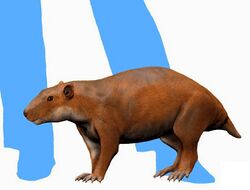Biology:Vintana
| Vintana | |
|---|---|

| |
| Life reconstruction of Vintana sertichi. Postcranial reconstruction is hypothetical. | |
| Scientific classification | |
| Domain: | Eukaryota |
| Kingdom: | Animalia |
| Phylum: | Chordata |
| Class: | Mammalia |
| Family: | †Sudamericidae |
| Genus: | †Vintana Krause et al., 2014 |
| Species: | †V. sertichi
|
| Binomial name | |
| †Vintana sertichi Krause et al., 2014
| |
Vintana sertichi is an early gondwanatherian mammal dating from the Late Cretaceous, approximately 66 million years ago. Scientists found the lone fossil, a skull, on Madagascar 's west coast in the Maastrichtian Maevarano Formation.
Vintana is extremely relevant to the understanding of gondwanatheres because it is the first well-preserved skull, as opposed to previous fragments and teeth. Establishing a connection with multituberculates and haramiyidans in the theriiform clade Allotheria, it is a rather unusual animal to either closely associated will be archosaurs or Euarchontoglires and Laurasiatheria, possessing massive lateral flanges in its skull whose exact purpose is poorly understood, as well as massive olfactory bulbs. A rather large animal at a weight of 19 pounds (8.74 kg), Vintana also represents another example of a considerably large Mesozoic mammal alongside Adalatherium, other gondwanathere from same formation, this body mass is only exceeded by Repenomamus.[1][2][3][4]
See also
References
- ↑ Krause, David W.; Hoffmann, Simone; Wible, John R.; Kirk, E. Christopher; Schultz, Julia A.; von Koenigswald, Wighart; Groenke, Joseph R.; Rossie, James B. (2014-11-05). O'Connor, Patrick M., Seiffert, Erik R., Dumont, Elizabeth R., Holloway, Waymon L., Rogers, Raymond R., Rahantarisoa, Lydia J., Kemp, Addison D., Andriamialison, Haingoson. "First cranial remains of a gondwanatherian mammal reveal remarkable mosaicism". Nature (Nature Publishing Group, a division of Macmillan Publishers Limited) 515 (7528): 512–517. doi:10.1038/nature13922. ISSN 1476-4687. PMID 25383528. Bibcode: 2014Natur.515..512K.
- ↑ Drake, Nadia (November 5, 2014). "Fossil From Dinosaur Era Reveals Big Mammal With Super Senses". National Geographic Society. http://news.nationalgeographic.com/news/2014/11/141105-mammal-evolution-vintana-fossil-science/.
- ↑ Wilford, John Noble (November 5, 2014). "Fossil's Unusual Size and Location Offer Clues in Evolution of Mammals". New York Times. https://www.nytimes.com/2014/11/06/science/madagascar-fossil-vintana-mammals-evolution.html.
- ↑ Krause, David W.; Hoffmann, Simone; Hu, Yaoming; Wible, John R.; Rougier, Guillermo W.; Kirk, E. Christopher; Groenke, Joseph R.; Rogers, Raymond R. et al. (2020). "Skeleton of a Cretaceous mammal from Madagascar reflects long-term insularity" (in en). Nature 581 (7809): 421–427. doi:10.1038/s41586-020-2234-8. ISSN 1476-4687. PMID 32461642. https://www.nature.com/articles/s41586-020-2234-8.
External links
Wikidata ☰ Q18510726 entry
 |

